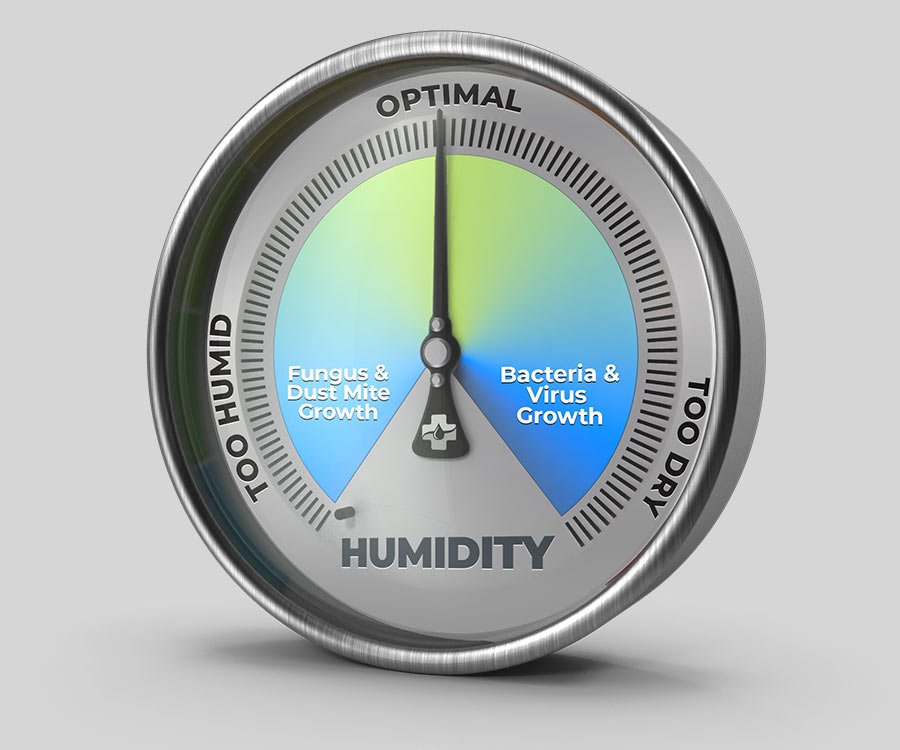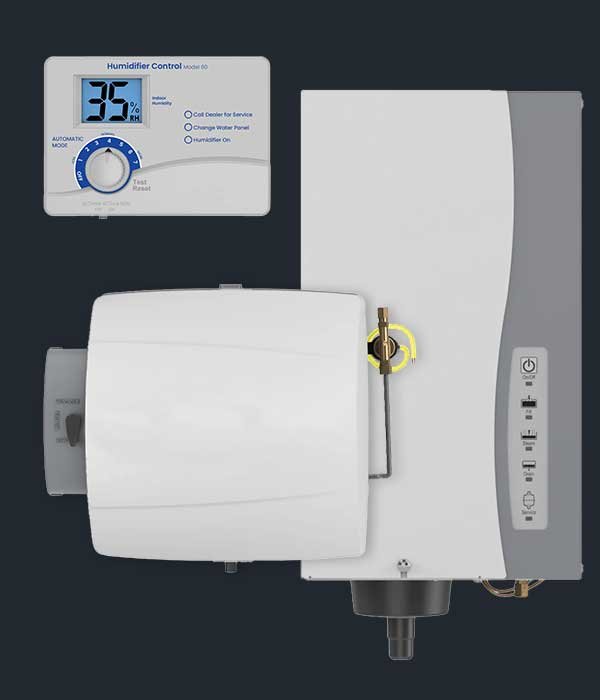Respiratory Health:
Too Low: Humidity below 30% can dry out respiratory passages, leading to irritation, coughing, and increased susceptibility to respiratory infections.
Optimal Range (30-50%): Maintains moisture in respiratory passages, reducing irritation and promoting better respiratory health.
Skin Health:
Too Low: Low humidity can cause dry skin, itching, and irritation.
Optimal Range (30-50%): Keeps skin hydrated, preventing dryness and associated discomfort.
Allergy and Asthma Management:
Too Low: Humidity above 50% can promote the growth of dust mites, mold, and mildew, exacerbating allergies and asthma.
Optimal Range (30-50%): Minimizes allergen presence, providing a healthier environment for allergy and asthma sufferers.
Thermal Comfort:
Too Low: Low humidity makes the air feel cooler than it is, potentially leading to discomfort in winter.
Optimal Range (30-50%): Balances thermal comfort, making indoor temperatures feel more consistent and comfortable year-round.

Optimal humidity refers to maintaining indoor air moisture levels between 30% and 50%.
Preventing Mold and Mildew:
Too Low: High humidity can lead to mold and mildew growth, damaging surfaces and posing health risks.
Optimal Range (30-50%): Prevents excessive moisture buildup, reducing the risk of mold and mildew.
Heating and Cooling Efficiency:
Optimal Range (30-50%): Proper humidity levels help maintain comfortable temperatures without over-reliance on heating or cooling systems, leading to energy savings.
Reduced HVAC Strain:
Optimal Range (30-50%): Balanced humidity reduces the workload on HVAC systems, decreasing wear and tear and extending their lifespan.
Wood Protection:
Too Low: Low humidity can cause wooden floors, furniture, and structural elements to crack and warp.
Optimal Range (30-50%): Maintains moisture levels in wood, preventing damage and prolonging the lifespan of wooden items.
1. Use Whole-Home Humidifiers and Dehumidifiers:
Dehumidifiers remove excess moisture during humid seasons, such as summer, to prevent humidity from rising too high.
Humidifiers add moisture to the air during dry seasons, such as winter, to maintain adequate humidity levels.
2. Ventilation:
Use exhaust fans in kitchens and bathrooms to remove excess moisture generated from cooking and showering.
Ensure your home is properly ventilated to allow for the circulation of fresh air, which helps regulate humidity levels.
3. Air Conditioning:
Air conditioners help reduce indoor humidity by cooling the air and removing excess moisture. Ensure your AC unit is appropriately sized and functioning correctly for optimal performance.
4. Monitor Humidity Levels:
Use a hygrometer to monitor indoor humidity levels regularly. This device will help you know when to take action to adjust humidity levels.
5. Seal Leaks and Insulate:
Check for and seal any leaks in windows, doors, and the roof to prevent moisture from entering your home.
Properly insulate your home to help maintain a stable indoor environment and reduce the impact of outdoor humidity.
6. Maintain Houseplants:
Houseplants can naturally increase humidity levels by releasing moisture into the air. However, be mindful not to overwater them, as this can lead to excessive humidity.
7. Proper HVAC Maintenance:
Regularly maintain your HVAC system to ensure it’s working efficiently. Clean or replace filters as needed to promote proper airflow and humidity control.
7. Address Water Sources:
Repair any plumbing leaks promptly to prevent excess moisture.
Ensure these areas are dry and well-ventilated to avoid moisture buildup.

Tips on Finding a Company to Improve the Air Quality Inside Your Home:
Online Reviews: Check reviews on platforms like Google, Yelp, and Better Business Bureau (BBB) to gauge customer satisfaction and reliability.
Industry Certifications: Ensure the company has certifications from reputable organizations such as the National Air Duct Cleaners Association (NADCA) or the Indoor Air Quality Association (IAQA).
Licensed and Insured: Verify that the company is licensed and carries insurance.
Years in Business: Choose a company with several years of experience in indoor air quality (IAQ) improvement.
Our air quality experts will show you exactly what contaminants are in your home and teach you how to protect your family.
Understand the levels of mold, dander, pollen, dust mites, and bacteria.
Discover how ,uch and what kinds of PMs are affecting your family.
Normaly costs over $150.00, now free!
Identify and take proactive steps to ensure a healthier indoor environment.
Understanding the carbon monoxide levels in your house is the first step to protect your family's health and wellness.
Click the button below and complete our quick survey to get started!
Click to Schedule-Free Air Quality Test-